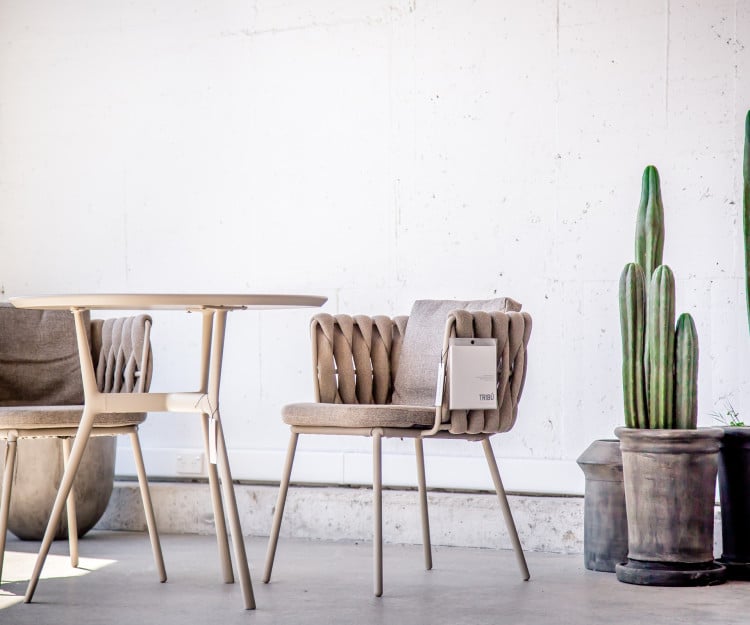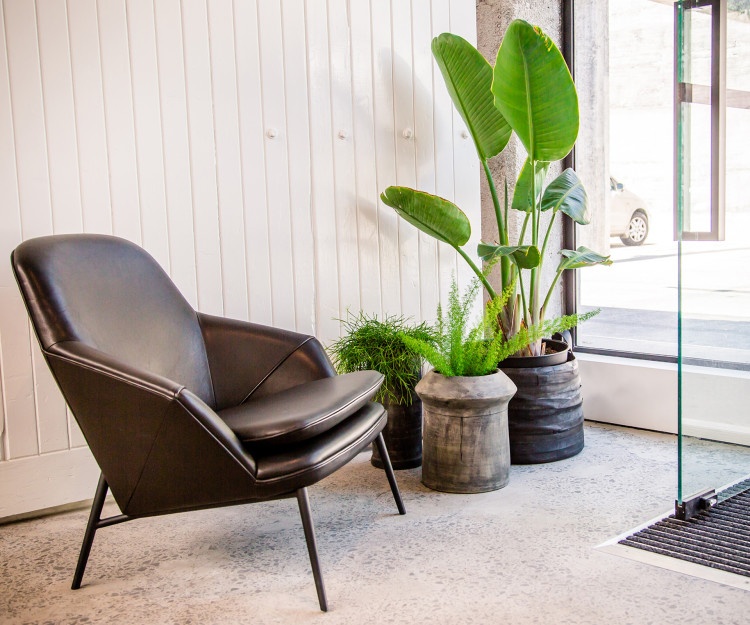Ryan McQuerry, director of interior plantscaping business Outside In, uses greenery to create a unique living environment in an Auckland furniture showroom
This showroom lies within a heritage building, and features a solid concrete exterior with a vast open space that needed a focal point. Ryan created a ‘living environment’ in the centre of the showroom; an unconventional and cost-effective solution.
Plants were also placed to spread greenery throughout the large warehouse – both vertically and horizontally – so that from any angle you look, you see greenery with beautiful furniture. The furniture gives the plants context, and on the other hand, greenery makes interior settings look more lively and interesting.
Primary and secondary canopies with different textures, layers and heights emulate how nature works outside. The primary canopy features two large Ficus Benjamina trees that act as a cover, overarching the living environment beneath. These trees enjoy indirect or filtered light, perfect for an indoor environment. The secondary canopy uses a range of ferns and reindeer moss from Scandinavia to replicate the forest floor (Ryan used this to create Cat and Jeremy’s bathroom moss wall on The Block NZ).
Words by: Shelley Ferguson. Photography by: Ruth Beale, Hope Photography.

1/10
Columnar cacti look just as amazing potted indoors as they do in landscapes. Display them in large pots to accommodate their weight, with well-drained soil and lots of light.

2/10
Bird of paradise (Strelitzia nicolai) adds a tropical look to any interior, and loves medium to high light conditions. Grouped with Springer’s asparagus fern (Asparagus aethiopicus) and Stick plant (Euphorbia) in a trio of earthy pots, they add instant impact to the entranceway.

3/10
Primary and secondary canopies with different textures, layers and heights emulate how nature works outside. The primary canopy features two large Ficus Benjamina trees that act as a cover, overarching the living environment beneath. These trees enjoy indirect or filtered light, perfect for an indoor environment. The secondary canopy uses a range of ferns and reindeer moss from Scandinavia to replicate the forest floor (Ryan used this to create Cat and Jeremy’s bathroom moss wall on The Block NZ).

4/10
Fiddle leaf fig (Ficus bambino) is having a major moment; its height and structural leaves make it a dramatic interior accent plant. It suits low to medium light, but gets sunburned if it’s in too much direct light. It’s teamed here with a large leaf Peace lily (Spathiphyllum) that’s easy to grow and enjoys low to medium light.

5/10
Succulents (Echeveria) and snake plants (Sansevieria) look gorgeous displayed in tiny terracotta pots.

6/10
Hanging plants are a space-savvy, stylish way of bringing the outside in, and there’s a range of vessels to suit every decor style. These hanging ceramic pots feature the String of Hearts plant (Ceropegia linearis woodii), that’s easy to grow, long-living and features pretty, lace-patterned leaves.

7/10
Got a dark outdoor corner featuring nothing more than dead space? Bring it to life with large white planters in varying sizes, filled with small trees, palms, shrubs and creepers in staggered heights for a waterfall effect of lush green plants.

8/10
Baby’s tears (Soleirolia) is a delicate creeping herb with bright green leaves that’s great as an accent plant as it drapes over the sides of pots and planters. It can thrive inside and loves moisture. Here, it pops against the natural timber table and feature wall.

9/10
Asparagus ferns are easy-to-grow houseplants that look great in this case potted on a tabletop, or in hanging planters. The stems of this evergreen perennial trail, climb and swoop upwards and outwards, which is why they’re an on-trend choice for hanging baskets.

10/10
Philodendron red congo.



